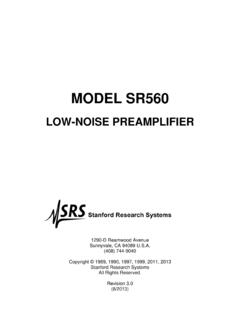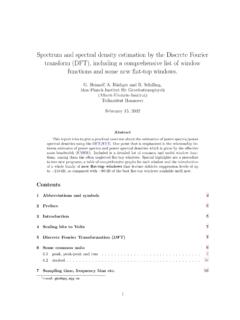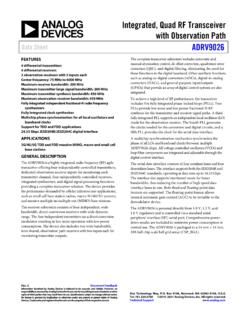Transcription of Active Low-Pass Filter Design (Rev. B) - Texas Instruments
1 Application ReportSLOA049B - September 20021 Active Low-Pass Filter DesignJim KarkiAAP Precision AnalogABSTRACTThis report focuses on Active Low-Pass Filter Design using operational amplifiers. Low-passfilters are commonly used to implement antialias filters in data-acquisition systems. Designof second-order filters is the main topic of tables are developed to simplify circuit Design based on the idea of cascading lower-order stages to realize higher-order filters. The tables contain scaling factors for the cornerfrequency and the required Q of each of the stages for the particular Filter being enables the designer to go straight to the calculations of the circuit-component illustrate an actual circuit implementation, six circuits, separated into three types of filters(Bessel, Butterworth, and Chebyshev) and two Filter configurations (Sallen-Key and MFB),are built using a TLV2772 operational amplifier.
2 Lab test data presented shows theirperformance. Limiting factors in the high-frequency performance of the filters are .. 2 Filter Characteristics3.. 3 Second-Order Low-Pass Filter Standard Form3.. 4 Math Review4.. 5 Examples4.. Second-Order Low-Pass Butterworth Filter5.. Second-Order Low-Pass Bessel Filter5.. Second-Order Low-Pass Chebyshev Filter With 3-dB Ripple5.. 6 Low-Pass Sallen-Key Architecture6.. 7 Low-Pass Multiple-Feedback (MFB) Architecture7.. 8 Cascading Filter Stages8.. 9 Filter Tables8.. 10 Example Circuit Test Results11.
3 11 Nonideal Circuit Operation14.. Nonideal Circuit Operation Sallen-Key14.. Nonideal Circuit Operation MFB16.. 12 Comments About Component Selection17.. 13 Conclusion17.. Appendix A Filter - Design Specifications19.. SLOA049B2 Active Low-Pass Filter DesignAppendix B Higher-Order Filters21.. List of Figures1 Low-Pass Sallen-Key Architecture6.. 2 Low-Pass MFB Architecture7.. 3 Building Even-Order Filters by Cascading Second-Order Stages8.. 4 Building Odd-Order Filters by Cascading Second-Order Stages and Adding a Single Real Pole8.. 5 Sallen-Key Circuit and Component Values fc = 1 kHz11.
4 6 MFB Circuit and Component Values fc = 1 kHz11.. 7 Second-Order Butterworth Filter Frequency Response12.. 8 Second-Order Bessel Filter Frequency Response12.. 9 Second-Order 3-dB Chebyshev Filter Frequency Response13.. 10 Second-Order Butterworth, Bessel, and 3-dB Chebyshev Filter Frequency Response13.. 11 Transient Response of the Three Filters14.. 12 Second-Order Low-Pass Sallen-Key High-Frequency Model14.. 13 Sallen-Key Butterworth Filter With RC Added in Series With the Output15.. 14 Second-Order Low-Pass MFB High-Frequency Model16.. 15 MFB Butterworth Filter With RC Added in Series With the Output16.
5 B 1 Fifth-Order Low-Pass Filter Topology Cascading Two Sallen-Key Stages and an RC22.. B 2 Sixth-Order Low-Pass Filter Topology Cascading Three MFB Stages23.. List of Tables1 Butterworth Filter Table9.. 2 Bessel Filter Table9.. 3 1-dB Chebyshev Filter Table10.. 4 3-dB Chebyshev Filter Table10.. 5 Summary of Filter Type Trade-Offs18.. 6 Summary of Architecture Trade-Offs18.. 1 IntroductionThere are many books that provide information on popular Filter types like the Butterworth,Bessel, and Chebyshev filters, just to name a few. This paper will examine how to implementthese three types of will examine the mathematics used to transform standard Filter - table data into the transferfunctions required to build Filter circuits.
6 Using the same method, Filter tables are developed thatenable the designer to go straight to the calculation of the required circuit-component Filter implementation is shown for two circuit topologies: the Sallen-Key and the MultipleFeedback (MFB). The Sallen-Key circuit is sometimes referred to as a voltage-controlled voltagesource, or VCVS, from a popular type of analysis is common practice to refer to a circuit as a Butterworth Filter or a Bessel Filter because itstransfer function has the same coefficients as the Butterworth or the Bessel polynomial.
7 It is alsocommon practice to refer to the MFB or Sallen-Key circuits as filters. The difference is that theButterworth Filter defines a transfer function that can be realized by many different circuittopologies (both Active and passive), while the MFB or Sallen-Key circuit defines an architectureor a circuit topology that can be used to realize various second-order transfer Active Low-Pass Filter DesignThe choice of circuit topology depends on performance requirements. The MFB is generallypreferred because it has better sensitivity to component variations and better high-frequencybehavior.
8 The unity-gain Sallen-Key inherently has the best gain accuracy because its gain isnot dependent on component CharacteristicsIf an ideal Low-Pass Filter existed, it would completely eliminate signals above the cutofffrequency, and perfectly pass signals below the cutoff frequency. In real filters, various trade-offsare made to get optimum performance for a given filters are termed maximally-flat-magnitude-response filters, optimized for gainflatness in the pass-band. the attenuation is 3 dB at the cutoff frequency. Above the cutofffrequency the attenuation is 20 dB/decade/order.
9 The transient response of a Butterworth filterto a pulse input shows moderate overshoot and filters are optimized for maximally-flat time delay (or constant-group delay). This meansthat they have linear phase response and excellent transient response to a pulse input. Thiscomes at the expense of flatness in the pass-band and rate of rolloff. The cutoff frequency isdefined as the 3-dB filters are designed to have ripple in the pass-band, but steeper rolloff after thecutoff frequency. Cutoff frequency is defined as the frequency at which the response falls belowthe ripple band.
10 For a given Filter order, a steeper cutoff can be achieved by allowing morepass-band ripple. The transient response of a Chebyshev Filter to a pulse input shows moreovershoot and ringing than a Butterworth Low-Pass Filter Standard FormThe transfer function HLP of a second-order Low-Pass Filter can be express as a function offrequency (f) as shown in Equation 1. We shall use this as our standard (f)+*K fFSF fc 2)1 QjfFSF fc)1 Equation 1. Second-Order Low-Pass Filter Standard FormIn this equation, f is the frequency variable, fc is the cutoff frequency, FSF is the frequencyscaling factor, and Q is the quality factor.















